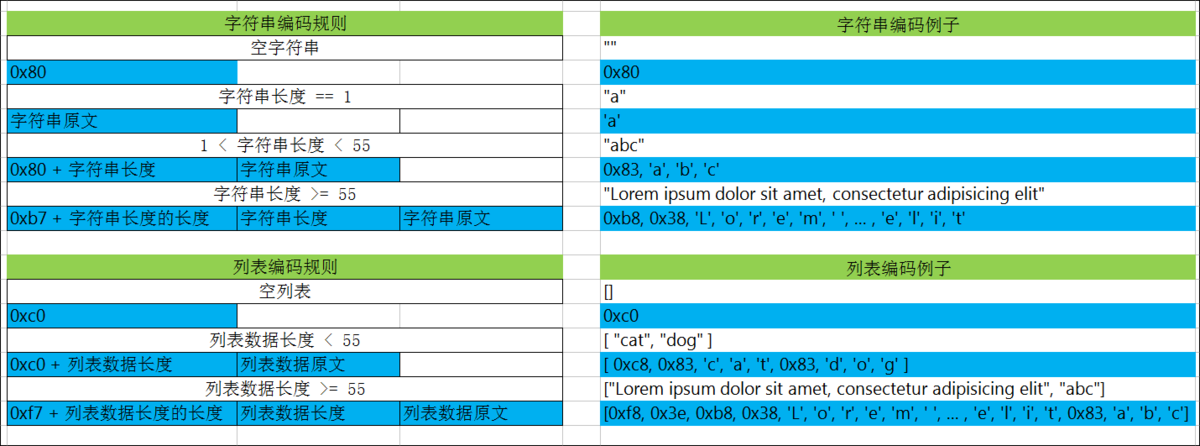在区块链的世界里,一方面由于是分布式存储,一样的数据存储在所有的节点里,如果数据中包含无用的字节,那么在所有节点中浪费的总量就很客观,另一方面虽然数字货币的交易速率都不高,但是至少也有每秒几笔(比特币)到几十笔(以太坊),如果每笔交易中都包含一定的无用字节,那么时间长了,就会浪费掉非常大的空间。
所以在比特币和以太坊中都有一些为了减少浪费而做的设计。
比特币 VarInt
VarInt (VI) 在比特币的 transaction 里面使用很多,用来表示后面跟的数据的字节数。在之前的 比特币-交易体 有过一些介绍,为了方便阅读这里再重复下,看下面这张图:

这是 transation TxIn 的一部分,里面的 VI 就是 VarInt,VI 的长度根据后面所跟数据的长度来变化,具体的定义:

如果数据长度小于 0xFD,那么就只有一个字节长度,本身就代表长度。
如果数据长度大于0xFD,那么第一个字节就是一个标示符,代表的是后面跟着的字节是什么类型的 Int,比如 uint16、uint32、uint64,这个 int 是数据的长度。
这种设计方式,目前已经为比特币节省了 10 多 G的存储空间。
以太坊 RLP(Recursive Length Prefix)
以太坊没有比特币那样复杂的交易体,只是一个简单的结构体,RLP 是用来解决结构体的编码问题。注意必须是大端字节序。
在 RLP 内也需要表示数据长度,所以也有类似 VarInt 的设计,先总体说下,然后看下代码。
1. 概述
RLP 只针对两种数据结构,字符串和列表,对于字典数据,以太坊有两种建议的方式,一种是通过二维数组表达键值对,比如[[k1,v1],[k2,v2]...],并且对键进行字典序排序;另一种方式是通过以太坊文档中提到的高级的基数树 编码来实现。
具体编码规则和例子如下:

字符串长度为 1 的情况比较特殊,列表的编码实际是个递归的过程,下面会说
2. 代码
这段代码来自 web3j,编码过程。
1
2
3
4
5
6
7
8
9
10
11
12
13
14
15
16
17
18
19
20
21
22
23
24
25
26
27
28
29
30
31
32
33
34
35
36
37
38
39
40
41
42
43
44
45
46
47
48
49
50
51
52
53
54
55
56
57
58
59
60
61
62
63
64
65
66
67
68
69
70
71
72
73
74
75
76
77
78
79
80
81
82
83
84
85
86
87
88
public class RlpEncoder {
// 判断编码类别,字符串还是列表
public static byte[] encode(RlpType value) {
if (value instanceof RlpString) {
return encodeString((RlpString) value);
} else {
return encodeList((RlpList) value);
}
}
// 编码流程,字符串和列表都是通过这个函数编码,只不过列表有一个迭代的过程
private static byte[] encode(byte[] bytesValue, int offset) {
// 对应于字符串编码,且长度为 1 的情况
if (bytesValue.length == 1
&& offset == OFFSET_SHORT_STRING // OFFSET_SHORT_STRING = 0x80
&& bytesValue[0] >= (byte) 0x00
&& bytesValue[0] <= (byte) 0x7f) {
// 直接返回字符串原文
return bytesValue;
// 长度小于 55 的情况
} else if (bytesValue.length < 55) {
byte[] result = new byte[bytesValue.length + 1];
// offset,字符串是0x80,列表是0xc0
result[0] = (byte) (offset + bytesValue.length);
System.arraycopy(bytesValue, 0, result, 1, bytesValue.length);
return result;
} else {
// 得到长度的长度的字节数组
byte[] encodedStringLength = toMinimalByteArray(bytesValue.length);
byte[] result = new byte[bytesValue.length + encodedStringLength.length + 1];
// offset,字符串是 0x80,列表是 0xc0,加上 0x37 之后,分别为 0xb7 和 0xf7
result[0] = (byte) ((offset + 0x37) + encodedStringLength.length);
System.arraycopy(encodedStringLength, 0, result, 1, encodedStringLength.length);
System.arraycopy(
bytesValue, 0, result, encodedStringLength.length + 1, bytesValue.length);
return result;
}
}
static byte[] encodeString(RlpString value) {
return encode(value.getBytes(), OFFSET_SHORT_STRING);
}
// 根据长度的长度计算字节流,按照大端的顺序写入到字节数组里,选择非 0 的最小段
private static byte[] toMinimalByteArray(int value) {
byte[] encoded = toByteArray(value);
for (int i = 0; i < encoded.length; i++) {
if (encoded[i] != 0) {
return Arrays.copyOfRange(encoded, i, encoded.length);
}
}
return new byte[]{ };
}
// 根据数值计算出字节流,按照大端顺序写入数组
private static byte[] toByteArray(int value) {
return new byte[] {
(byte) ((value >> 24) & 0xff),
(byte) ((value >> 16) & 0xff),
(byte) ((value >> 8) & 0xff),
(byte) (value & 0xff)
};
}
// 将列表迭代编码
static byte[] encodeList(RlpList value) {
List<RlpType> values = value.getValues();
if (values.isEmpty()) {
return encode(new byte[]{ }, OFFSET_SHORT_LIST); // OFFSET_SHORT_LIST = 0xc0
} else {
byte[] result = new byte[0];
for (RlpType entry:values) {
result = concat(result, encode(entry));
}
return encode(result, OFFSET_SHORT_LIST); // OFFSET_SHORT_LIST = 0xc0
}
}
// 链接数组
private static byte[] concat(byte[] b1, byte[] b2) {
byte[] result = Arrays.copyOf(b1, b1.length + b2.length);
System.arraycopy(b2, 0, result, b1.length, b2.length);
return result;
}
}
